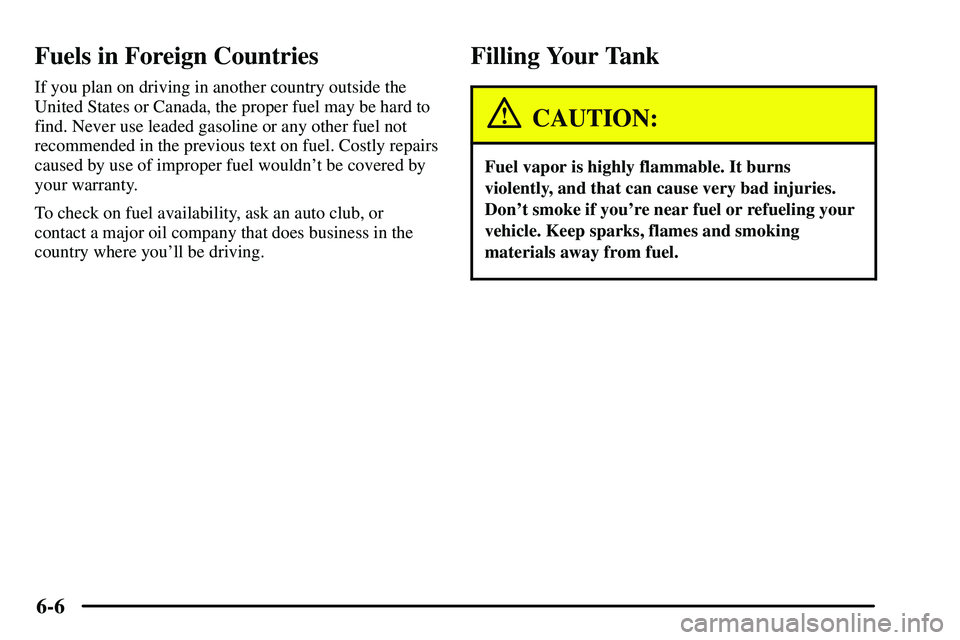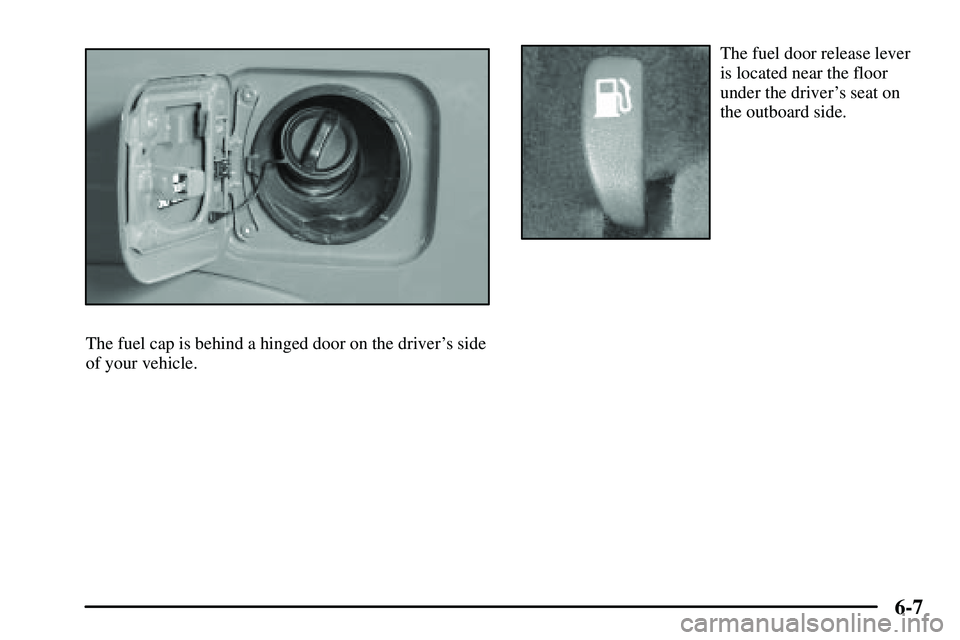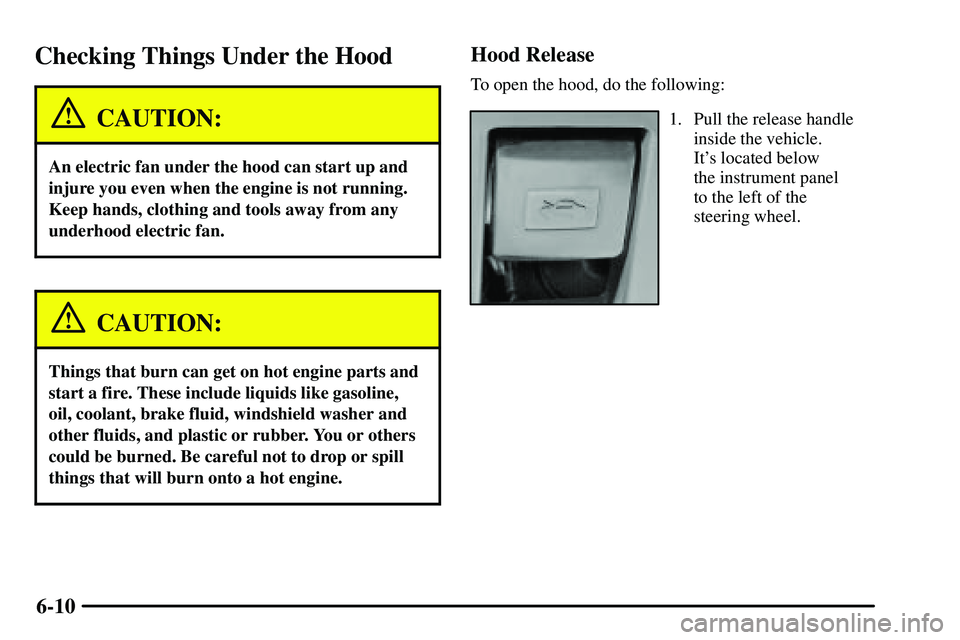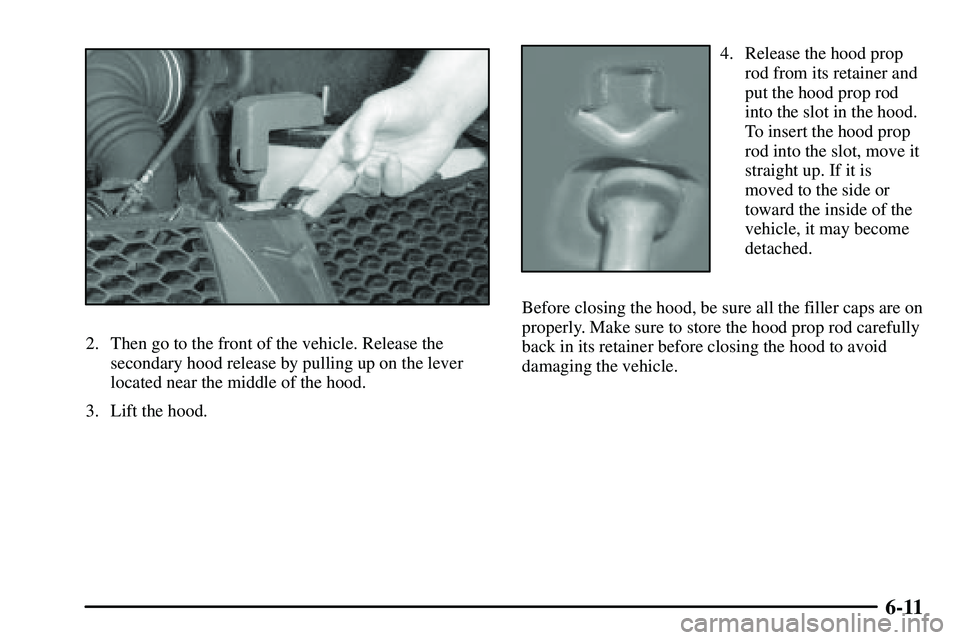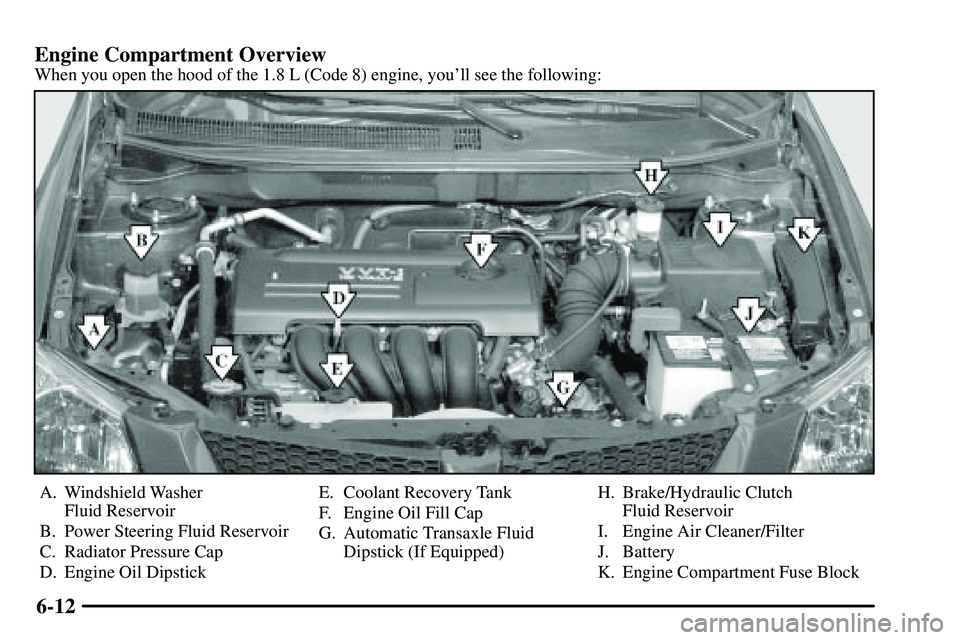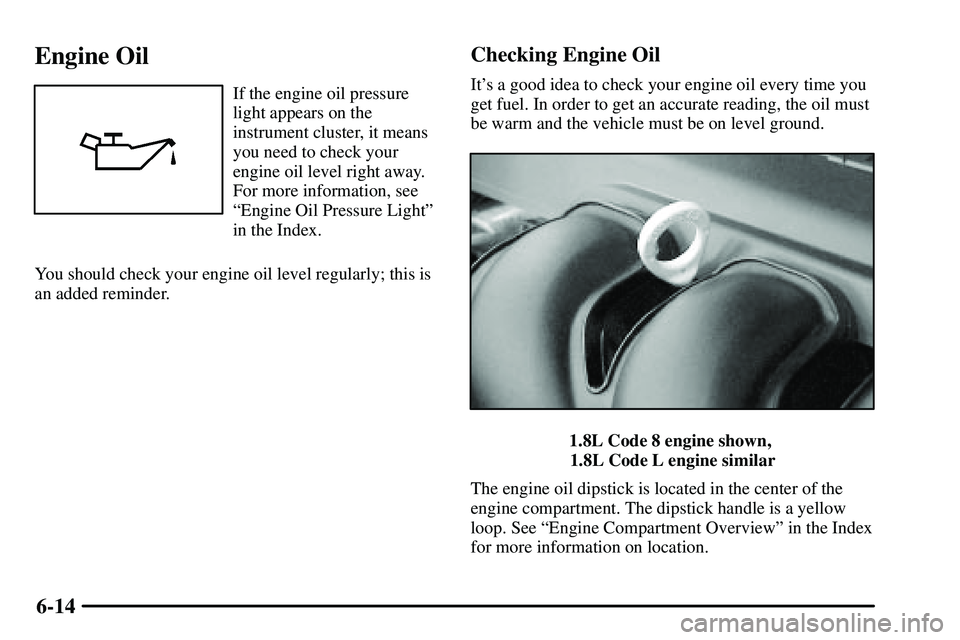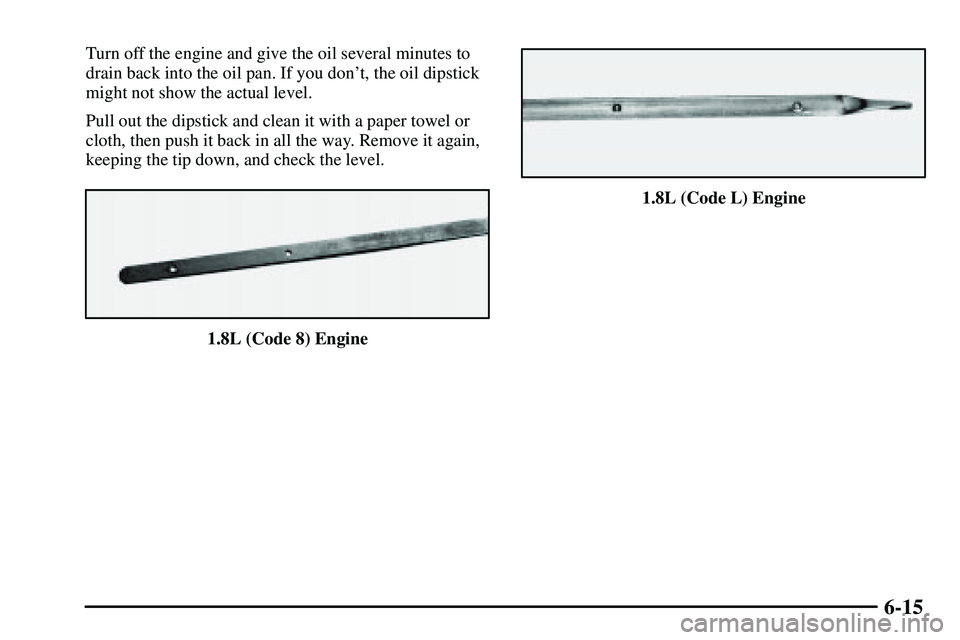PONTIAC VIBE 2003 Owners Manual
VIBE 2003
PONTIAC
PONTIAC
https://www.carmanualsonline.info/img/50/40867/w960_40867-0.png
PONTIAC VIBE 2003 Owners Manual
Trending: sensor, park assist, wheel, oil filter, recommended oil, overheating, radio
Page 251 of 381
6-6
Fuels in Foreign Countries
If you plan on driving in another country outside the
United States or Canada, the proper fuel may be hard to
find. Never use leaded gasoline or any other fuel not
recommended in the previous text on fuel. Costly repairs
caused by use of improper fuel wouldn't be covered by
your warranty.
To check on fuel availability, ask an auto club, or
contact a major oil company that does business in the
country where you'll be driving.
Filling Your Tank
CAUTION:
Fuel vapor is highly flammable. It burns
violently, and that can cause very bad injuries.
Don't smoke if you're near fuel or refueling your
vehicle. Keep sparks, flames and smoking
materials away from fuel.
Page 252 of 381
6-7
The fuel cap is behind a hinged door on the driver's side
of your vehicle.
The fuel door release lever
is located near the floor
under the driver's seat on
the outboard side.
Page 253 of 381
6-8
While refueling, hang the fuel cap inside the fuel door.
To remove the fuel cap, turn it slowly to the left
(counterclockwise).
CAUTION:
If you get fuel on yourself and then something
ignites it, you could be badly burned. Fuel can
spray out on you if you open the fuel cap too
quickly. This spray can happen if your tank is
nearly full, and is more likely in hot weather.
Open the fuel cap slowly and wait for any ªhissº
noise to stop. Then unscrew the cap all the way.
Be careful not to spill fuel. Clean fuel from painted
surfaces as soon as possible. See ªCleaning the Outside
of Your Vehicleº in the Index.
Page 254 of 381
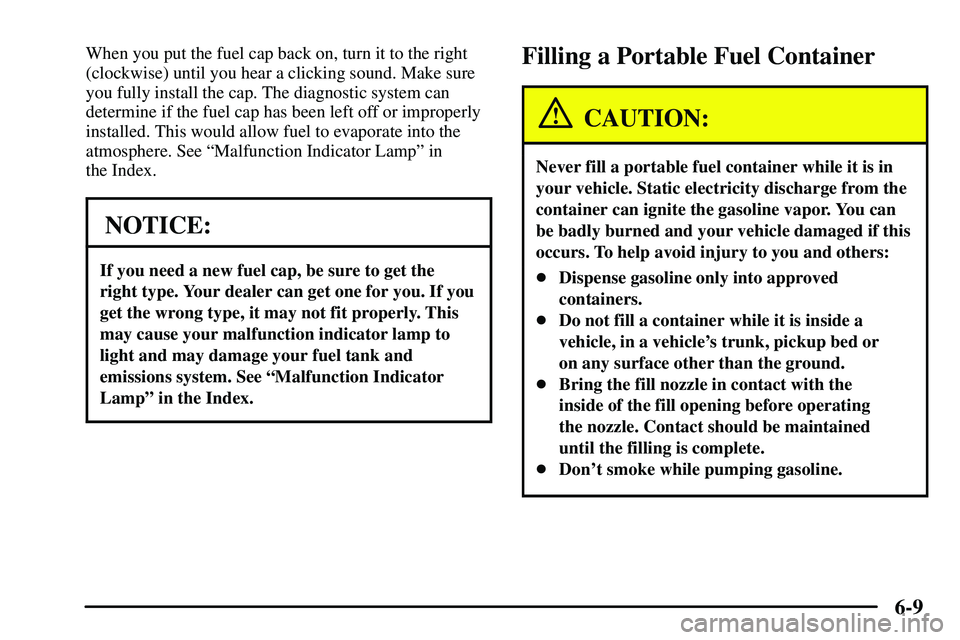
6-9
When you put the fuel cap back on, turn it to the right
(clockwise) until you hear a clicking sound. Make sure
you fully install the cap. The diagnostic system can
determine if the fuel cap has been left off or improperly
installed. This would allow fuel to evaporate into the
atmosphere. See ªMalfunction Indicator Lampº in
the Index.
NOTICE:
If you need a new fuel cap, be sure to get the
right type. Your dealer can get one for you. If you
get the wrong type, it may not fit properly. This
may cause your malfunction indicator lamp to
light and may damage your fuel tank and
emissions system. See ªMalfunction Indicator
Lampº in the Index.
Filling a Portable Fuel Container
CAUTION:
Never fill a portable fuel container while it is in
your vehicle. Static electricity discharge from the
container can ignite the gasoline vapor. You can
be badly burned and your vehicle damaged if this
occurs. To help avoid injury to you and others:
�Dispense gasoline only into approved
containers.
�Do not fill a container while it is inside a
vehicle, in a vehicle's trunk, pickup bed or
on any surface other than the ground.
�Bring the fill nozzle in contact with the
inside of the fill opening before operating
the nozzle. Contact should be maintained
until the filling is complete.
�Don't smoke while pumping gasoline.
Page 255 of 381
6-10
Checking Things Under the Hood
CAUTION:
An electric fan under the hood can start up and
injure you even when the engine is not running.
Keep hands, clothing and tools away from any
underhood electric fan.
CAUTION:
Things that burn can get on hot engine parts and
start a fire. These include liquids like gasoline,
oil, coolant, brake fluid, windshield washer and
other fluids, and plastic or rubber. You or others
could be burned. Be careful not to drop or spill
things that will burn onto a hot engine.
Hood Release
To open the hood, do the following:
1. Pull the release handle
inside the vehicle.
It's located below
the instrument panel
to the left of the
steering wheel.
Page 256 of 381
6-11
2. Then go to the front of the vehicle. Release the
secondary hood release by pulling up on the lever
located near the middle of the hood.
3. Lift the hood.
4. Release the hood prop
rod from its retainer and
put the hood prop rod
into the slot in the hood.
To insert the hood prop
rod into the slot, move it
straight up. If it is
moved to the side or
toward the inside of the
vehicle, it may become
detached.
Before closing the hood, be sure all the filler caps are on
properly. Make sure to store the hood prop rod carefully
back in its retainer before closing the hood to avoid
damaging the vehicle.
Page 257 of 381
6-12 Engine Compartment Overview
When you open the hood of the 1.8 L (Code 8) engine, you'll see the following:
A. Windshield Washer
Fluid Reservoir
B. Power Steering Fluid Reservoir
C. Radiator Pressure Cap
D. Engine Oil DipstickE. Coolant Recovery Tank
F. Engine Oil Fill Cap
G. Automatic Transaxle Fluid
Dipstick (If Equipped)H. Brake/Hydraulic Clutch
Fluid Reservoir
I. Engine Air Cleaner/Filter
J. Battery
K. Engine Compartment Fuse Block
Page 258 of 381
6-13
When you open the hood of the 1.8 L (Code L) H.O. DOHC engine, you'll see the following:
A. Windshield Washer Fluid
Reservoir
B. Power Steering Fluid Reservoir
C. Radiator Pressure Cap
D. Engine Oil DipstickE. Coolant Recovery Tank
F. Engine Oil Fill Cap
G. Automatic Transaxle Fluid
Dipstick (If Equipped)H. Brake/Hydraulic Clutch Fluid
Reservoir
I. Engine Air Cleaner/Filter
J. Battery
K. Engine Compartment Fuse Block
Page 259 of 381
6-14
Engine Oil
If the engine oil pressure
light appears on the
instrument cluster, it means
you need to check your
engine oil level right away.
For more information, see
ªEngine Oil Pressure Lightº
in the Index.
You should check your engine oil level regularly; this is
an added reminder.
Checking Engine Oil
It's a good idea to check your engine oil every time you
get fuel. In order to get an accurate reading, the oil must
be warm and the vehicle must be on level ground.
1.8L Code 8 engine shown,
1.8L Code L engine similar
The engine oil dipstick is located in the center of the
engine compartment. The dipstick handle is a yellow
loop. See ªEngine Compartment Overviewº in the Index
for more information on location.
Page 260 of 381
6-15
Turn off the engine and give the oil several minutes to
drain back into the oil pan. If you don't, the oil dipstick
might not show the actual level.
Pull out the dipstick and clean it with a paper towel or
cloth, then push it back in all the way. Remove it again,
keeping the tip down, and check the level.
1.8L (Code 8) Engine
1.8L (Code L) Engine
Trending: manual radio set, checking oil, run flat, ignition, Transmission, spare wheel, air suspension
